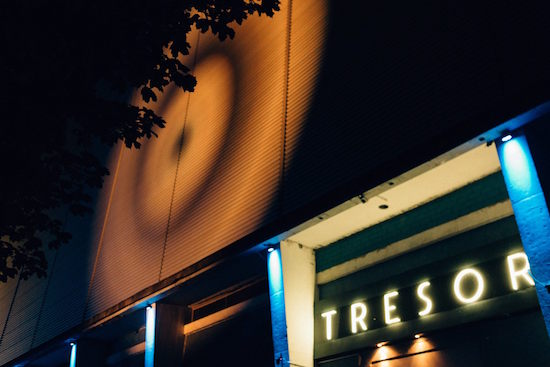Berlin. Techno. Tresor. A fantastic triumvirate, twenty-five years in the forging. And it seems that in celebrating its silver jubilee, Tresor – or its indefatigable founder, Dimitri Hegemann – is intensifying the intent behind this founding, working to make the links as solid as the reinforced concrete that props up the magnificent Kraftwerk complex where the festival takes place.
Hegemann is, quite rightly, seen as an authority on all things techno, having initiated its European inception and the establishment of the Berlin-Detroit axis, and his scope appears to be growing more ambitious with each year. Aside from overseeing the running of Tresor and its in-house label, he has resurrected the Atonal festival, is in the final stages of planning a techno museum to be housed in Kraftwerk, and is exploring the possibility of opening a community arts/club space in Detroit’s Fischer Body Plant 21.
All of these projects constitute the building blocks of a formidable and monolithic brand, an institution, a physical and spiritual “Home of Techno”. The press release for the 25 Years Festival proclaimed the line-up to be “a who’s who of electronic music history” – a bold but substantiated claim, yet also one which seems to represent the first explicit and seemingly irrefutable statement of a canon of electronic music. Of course it could be argued that every line-up, be it for a festival, club night or gig, is in some way canonising the artists, yet few have done so with this degree of bombastic rhetoric, or such acute historical consciousness.

The problem with canons, as we well know, is that they exclude and smooth away differences in order to present a single, cohesive narrative. Thus the Tresor 25 Years Festival set itself up (purposively or not) with the mammoth task of navigating this sensitive issue – a walk of the tight-rope which, if successful, would keep the doors open for expansion, diversity and innovation; and, if not, would appear as a sort of rose-tinted retrospective for a culture already reified and poised for decline. In many ways, the line-up itself constituted the event, expressly designed for posterity: Simply by being announced, it had already happened, and the actual music-making that took place was to be an enjoyable formality.
The first “exclusion” programmed by the festival is the elimination of everything but techno, though obviously what we know and love Tresor for, expecting nothing less. Nevertheless, for three days and four nights, Köpernicker Strasse throbbed with an incessant, grinding 4/4. All the artists on the line-up have enjoyed a solid relationship with either the club or the label, and it is remarkable to hear how Tresor’s sonic identity has remained so intact over the years, from early stalwarts like Blake Baxter and Juan Atkins, through to more recent signings like Marcelus. There is a scruffy, roughly-hewn quality to the Tresor sound, which is not to say that it is careless, rather that it revels in the tactile materiality that techno can afford, mirrored in (and doubtlessly inspired by) the multifarious venues within Kraftwerk.
Everything inside is open to the senses, from the delicious musk and concrete monumentality of its lower hall, to the kitsch-y slickness of Globus, and the red-lit slaughterhouse tiles that adorn OHM’s walls. The subterranean bunker that is Tresor can in itself push you into sensory overload, with its impenetrable fog, rough woodwork, iron cages, and maze of steps and cloisters. Its structural idiosyncrasies make damn sure that you are never at ease, trying to work out whether the word “DECADENCE” graffitied on the walls has even a hint of irony, while a battery of percussion rips through the soundsystem.
And batter and rip it does. Throughout the festival the music is raw, abrasive, and unrepentant. Yet within what could be seen as a fairly limited palette, individual artists’ nuances shine through. Automat provides one of the more outlandish sets – their sultry, metal-infused drones easing in Friday’s crowd. Dasha Rush, following on, takes it from nought to techno in less than two minutes with a glittering, high octane performance, which only comes up for air in the very last track. Donato Dozzy takes the exact opposite approach: For a full twenty minutes, there is little to hear but an austere kick drum. Dozzy’s music is famed for its luminescent fragility and textured hypnosis, but this set seems to actively reject any discernible affect. It’s gunpowder grey and tantalisingly hollow – not aggressive, not “dark”, not beautiful in any conventional sense of the word – just complex, anonymous rhythms etching out their own time frame, and playing with ours.
Still, though, all this presents a fairly narrow spectrum. O/V/R, Refracted, and TR-101 bring much-needed depth and space to the proceedings, while Regis and Surgeon serve up an unmistakeably British brand of rowdiness. The hotly anticipated set by Juan Atkins and Moritz von Oswald, playing as Borderland, receives a huge ovation, but to these ears sounds as though it has lost some of the crystalline vitality of the album: new drops seem to ground it too heartily in the here-and-now. Even ‘Merkur’, that most airborne of tracks, sags under its new-found weight, though perhaps this was an unforeseen acoustical eccentricity effected by the vastness of the venue.

DJ Stingray and Helena Hauff offer a genuine alternative to what, over four days, often feels like an endurance test. They provide exhilaration: Withering, frenzied electro, dancers packed like sardines inside OHM – here we can really purify, purge, and transfer our habitual exigencies. No doubt Objekt looks to do the same, but given the Sunday afternoon fatigue and scorching sun outside, his replacement – Sarah Miles – and Binh, who stands in for Acronym, are wise to keep the considerably diminished crowd simply simmering, with soft trips and energising, classic house.
A 1988 article in The Face described techno as a “post-soul sound [which] says nothing to the Lord”. And it is true – the music at the 25 Years Festival does not cater openly for the spirit. The ritualism of it all, though, is striking. Wearing their Sunday best, a large proportion of the Tresor crowd, still awake, head over to Berghain in the evening for the closing set with Steffi b2b Dettmann; a line-up which looks good on paper, but turns into twelve remarkably uninspired hours.
Tresor, with only Globus open, manages to harbour that last smidgeon of energy and effervesce to conclusion with Ellen Allien and Tanith. Given Berlin’s “fluid” approach to the concept of the weekend, the one-off, celebratory aspect of the festival is somewhat diminished, buried among all the other unmissable parties going on within a five mile radius. On the other hand, maybe this certitude of plenitude is cause for celebration in itself, and anything other than a business-as-usual attitude would have turned the whole thing into a caricature of itself.
The 25 Years Festival delivers a hitherto-unbeaten programme of techno while making it seem like just another weekend. And it is this that represents its crowning achievement. Over two decades, Tresor has raised the underground into visibility and created an institution. The struggle is over, the ineffable is reified, and in the following weekends when the crowds reconvene, they will have to dance harder in order show that this reification hasn’t castrated their hedonism, and that what has been uncovered still has the potential to liberate and effect change.


